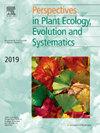Drought resistance and drought adaptation of Douglas-fir (Pseudotsuga menziesii) – A review
IF 3.5
3区 环境科学与生态学
Q1 ECOLOGY
Perspectives in Plant Ecology Evolution and Systematics
Pub Date : 2024-11-01
DOI:10.1016/j.ppees.2024.125829
引用次数: 0
Abstract
The rise in temperatures with climate warming exposes trees and forests on Earth to a triple threat through increased soil drought, enhanced atmospheric drought, and growing heat stress. Understanding which tree species are susceptible to mortality under a more arid future climate is urgent. Here, we review recent progress in our understanding of the drought and heat response of Douglas-fir (Pseudotsuga menziesii, DF) in all relevant fields of research, spanning from stomatal regulation and photosynthetic responses, plant water status dynamics and the vulnerability of the hydraulic system, to adaptive responses of the root system, the climate sensitivity of growth, and climate change-related tree vitality declines and die-off. The species’ high productivity is linked to large leaf areas at maturity, which cause fairly high interception and transpiration rates and often result in effective soil moisture depletion and reduced groundwater recharge. While hydraulic safety is high in DF branch xylem, embolism seems common in the xylem of terminal branchlets and small roots during summer drought. The existing evidence suggests that the photosynthetic apparatus and growth rate of DF are fairly heat-sensitive in comparison to other tree species, with impairment of photosynthesis starting at temperatures of ∼40 °C. A key growth-limiting factor is a high atmospheric saturation deficit, which causes partial stomatal closure and growth decline in summer, explaining high productivity in more humid maritime climates. We explore population, provenance and variety differences in the resistance to drought and heat and the related capacity to adapt, and compare the performance of Douglas-fir to that of other tree species. Across provenances and families, trade-offs between productivity and drought resistance, cold resistance and heat resistance have emerged, and more drought-resistant provenances are often less cold-hardy. Recent hot droughts have caused vitality decline and local stand-level die-off in DF in the drier parts of the U.S. and in some European regions. For the economically important coastal variety (P. m. var. menziesii), the existing evidence suggests considerable vulnerability to a future warmer and drier climate, especially in the warmer lowlands, while the interior variety (P. m. var. glauca) may perform better. Perspectives for the silviculture of Douglas fir in a warmer world are outlined.
花旗松(Pseudotsuga menziesii)的抗旱性和干旱适应性 - 综述
随着气候变暖,气温升高,地球上的树木和森林面临着土壤干旱加剧、大气干旱增强和热应力增加的三重威胁。当务之急是了解哪些树种在未来更加干旱的气候条件下容易死亡。在此,我们回顾了最近在了解花旗松(Pseudotsuga menziesii, DF)的干旱和热响应方面取得的进展,这些进展涉及所有相关研究领域,包括气孔调节和光合响应、植物水分状态动态和水力系统的脆弱性、根系的适应性响应、生长的气候敏感性以及与气候变化相关的树木生命力下降和死亡。该树种的高生产力与成熟时的大面积叶片有关,叶片的截流率和蒸腾率相当高,往往导致土壤水分的有效消耗和地下水补给的减少。虽然 DF 树枝木质部的水力安全性很高,但在夏季干旱期间,顶生小枝和小根的木质部似乎经常发生栓塞。现有证据表明,与其他树种相比,DF 的光合作用装置和生长速度对热相当敏感,在温度达到 40 ℃ 时光合作用就开始受到影响。限制生长的一个关键因素是大气饱和赤字较高,这会导致气孔部分关闭和夏季生长衰退,这也是海洋性气候较为潮湿地区生产率较高的原因。我们探讨了种群、原产地和品种在抗旱和抗热以及相关适应能力方面的差异,并将花旗松的表现与其他树种进行了比较。在不同的产地和科系中,生产力与抗旱性、抗寒性和抗热性之间出现了权衡,抗旱性较强的产地往往抗寒性较差。最近的高温干旱导致美国较干旱地区和欧洲一些地区的 DF 生命力下降,出现局部枯死现象。对于具有重要经济价值的沿海品种(P. m. var. menziesii)来说,现有证据表明其在未来更温暖、更干旱的气候条件下相当脆弱,尤其是在更温暖的低地,而内陆品种(P. m. var. glauca)可能表现得更好。本文概述了在气候变暖的情况下花旗松造林的前景。
本文章由计算机程序翻译,如有差异,请以英文原文为准。
求助全文
约1分钟内获得全文
求助全文
来源期刊
CiteScore
6.50
自引率
0.00%
发文量
28
审稿时长
67 days
期刊介绍:
Perspectives in Plant Ecology, Evolution and Systematics (PPEES) publishes outstanding and thought-provoking articles of general interest to an international readership in the fields of plant ecology, evolution and systematics. Of particular interest are longer, in-depth articles that provide a broad understanding of key topics in the field. There are six issues per year.
The following types of article will be considered:
Full length reviews
Essay reviews
Longer research articles
Meta-analyses
Foundational methodological or empirical papers from large consortia or long-term ecological research sites (LTER).

 求助内容:
求助内容: 应助结果提醒方式:
应助结果提醒方式:


